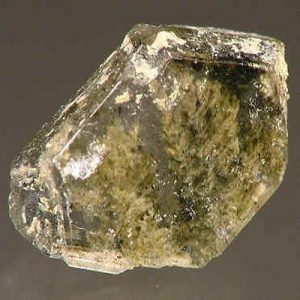Pirssonite
Pirssonite is named after American geologist Louis Valentine Pirsson. Pirssonite is one of several carbonate minerals that form in non-marine evaporite deposits. The chemical formula of Pirssonite is Na2Ca(CO3)2•2(H2O) and its molecular weight is 242.11 gm. Other evaporite carbonates include trona, gaylussite, northupite, nahcolite and thermonatrite. Evaporite minerals are geologically important because they clearly are related to the environmental conditions that existed at the time of their deposition, namely arid. They also can be easily recrystallized in laboratories in order to confirm their specific characteristics of the formation. include the type locality at Searles Lake, San Bernardino County, California as well as Deep Spring Lake, Inyo County and Borax Lake, Lake County, California, USA; Mont Saint-Hilaire, Quebec, Canada and elsewhere.
Pirssonite and gaylussite, Na2Ca(CO 3)2 – 5H2O, differ only in the number of water molecules, yet their symmetries are quite different. This is an indication of a change in their respective crystal structures. The two are best distinguished by their crystal habits in which pirssonite has a distinctive tabular diamond-shaped crystal form. Pirssonite can lose its water molecules and specimens should be stored in a sealed container.
In the USA, in California, from Searles Lake, San Bernardino Co., at Borax Lake, Lake Co., in Deep Spring Lake, Inyo Co., and at Owens Lake, Mono Co.; in the John Hay, Jr. Well No. 1, about 30 km west of Green River, Sweetwater Co., Wyoming. On the Arizaro, Pastos Grandes, and Pozuelos playas, Salta Province, Argentina. From the Jequetepeque River Valley, northwest Peru. On the Otjiwalundo Salt Pan, about 400 km west-northwest of Otavi, Namibia. In the Beypazari Basin, Ankara, Turkey. On Mt. Kukisvumchorr, Khibiny massif, and Mt. Alluaiv, Lovozero massif, Kola Peninsula, Russia.
| Chemical Formula: | Na2Ca(CO3)2•2(H2O) |
| Molecular Weight: | 242.11 gm |
| Crystallography: | Orthorhombic – Pyramidal |
| Crystal Habit: | Hemimorphic crystals, to 2 cm; granular, massive, maybe as efflorescences. |
| Twinning: | None |
| Composition: | Sodium | 18.99 % | Na | 25.60 % | Na2O |
| Calcium | 16.55 % | Ca | 23.16 % | CaO | |
| Hydrogen | 1.67 % | H | 14.88 % | H2O | |
| Carbon | 9.92 % | C | 36.36 % | CO2 | |
| Oxygen | 52.87 % | O | |||
| 100.00% | 100.00% | =TOTAL OXIDE |
| Cleavage: | None |
| Fracture: | Conchoidal |
| Tenacity: | Brittle |
| Hardness (Mohs): | 3.0 – 3.5 |
| Density: | 2.352 – 2.382 (g/cm3) |
| Luminescence: | Fluorescent and Phosphorescent; SW UV = weak blue-white to blue-gray |
| Radioactivity: | Not Radioactive |
| Other: | Pyroelectric; with the end of the [001] axis terminated by {131} becoming negatively electrified on cooling. Soluble in H2O, leaving CaCO3. |
| Color: | Colorless, Grayish, White |
| Transparency: | Transparent to Translucent |
| Luster: | Vitreous |
| Refractive Index: | 1.5043 – 1.5751 Biaxial ( + ) |
| Birefringence: | 0.0708 |
| Dispersion: | Relatively Weak; r < v |
| Pleochroism: | None |


